What are Nag Panchami (Chaturthi) information (facts) (significance) (importance) | Why Hindus worship snake | Are Hindus (Indians) snake charmers?
Namaste friends, how are you doing today? Welcome to #BhagavanBhakthi website / blog.
Bhagavan Lord Sri Krishna blessings to you and your family!
In this website / blog, you will always learn about #Hinduism #Sanskrit language.
Also subscribe to my YouTube channel from this link #BhagavanBhakthi to view videos about #Hinduism #Sanskrit language.
Just before moving towards to know about “What are Nag Panchami (Chaturthi) information (facts) (significance) (importance) | Why Hindus worship snake | Are Hindus (Indians) snake charmers?“, let us know few basic and important information.
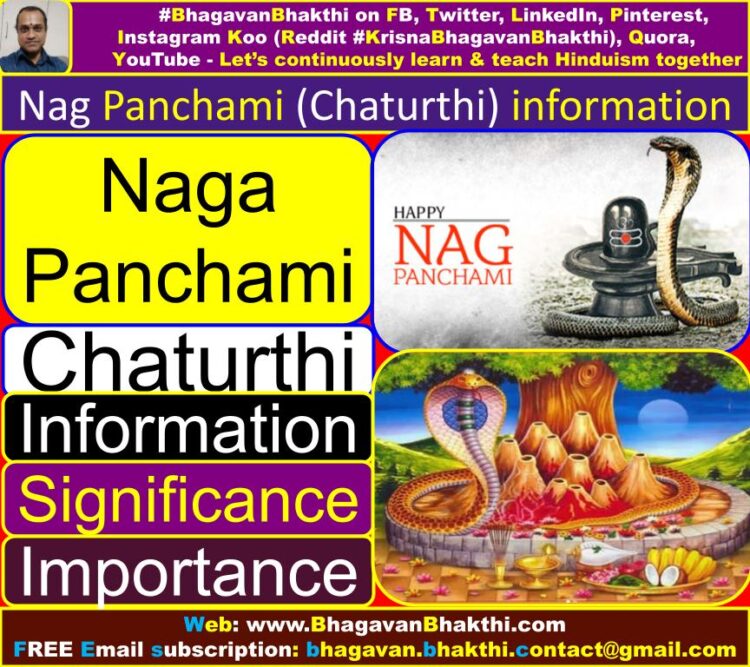
Naga Panchami (Nag Panchami) means, Naga + Panchami = Divine Snake God + 5th day.
Here we celebrate the Naga Panchami on the 5th (Panchami Tithi) of Shravana masam (month), Shukla Paksha every year.
Similarly, Nag Chaturthi / Naga Chaturthi / Nag Chauthi means, Naga + Chaturthi (Chauthi) = Divine Snake God + 4th day.
We celebrate the Naga Chaturthi (Chauthi) on the 4th (Chaturhi Tithi) of Shravana masam (month), Shukla Paksha every year.
We should always remember that, all Nagas (snakes) are not Gods (Devatas / Demigods).
Europeans, Americans, etc. have always blamed Hindus as snake charmers, Hindus worship snakes, which is completely incorrect.
We don’t worship snakes, but rather we only worship the divine Naga Devatas as per the instructions given in Hindu texts like Mahabharata, Puranas, etc.
Many of us celebrate Naga (Nag) Panchami or Naga (Nag) Chaturthi every year. Now let us more information about this unique and divine festival.

(Many people pronounce Naga as Nag or Nagam or Nagan or Nagara etc.)
(This difference is present as people of particular region, have their own way or pronouncing words as per their own dialect.)
List of Nag Panchami (Chaturthi) facts is as given below:
Mainly there are three main divine Nagas in Hinduism | First is Lord AdiShesha Naga |
Second is Lord Subramanya (Kartikeya) | Third is Lord Vasuki | Lord AdiShesha Naga is the bed of Lord Vishnu |
Lord Subramanya (Kartikeya) is the son of Lord Shiva | Lord Vasuki is the divine Naga present around the neck of Lord Shiva |
All these Nagas are children of Kadru and Maharishi Kashyapa | Naga Devata Kshetras (pilgrimage places) (Given below) |
Meaning of Naga (Given below) | What Upanishad tells about Lord AdiShesha (Given below) |
Why shuchi (cleanliness) is important during Naga Panchami (Given below) | Short story about Bhima and Nagas | And many more…
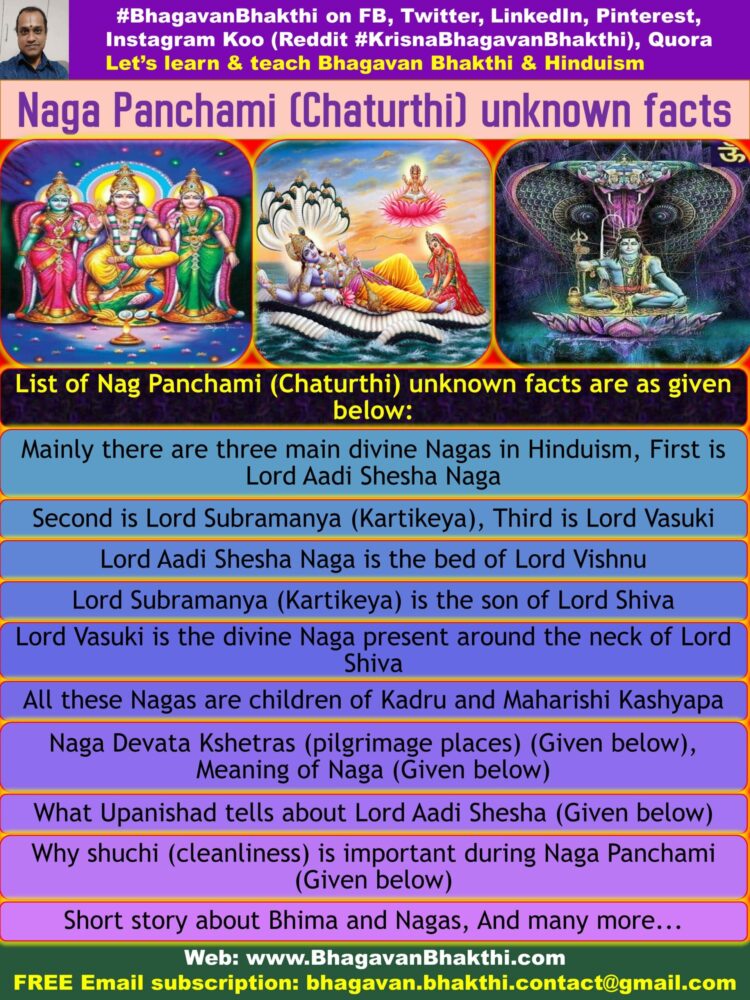
Now, let us start to know more information about this divine festival as per Hindu Shastras (Texts).
Mainly there are three types of divine Nagas or Sarpas (Devatas / Snake Demigods) according to our Shastras (Hindu Texts). They are as given below:
1. Lord Adishesha Deva or Sri AdiShesha Naga or Sri Ananta Shesha Deva (same Demigod, with three different names)
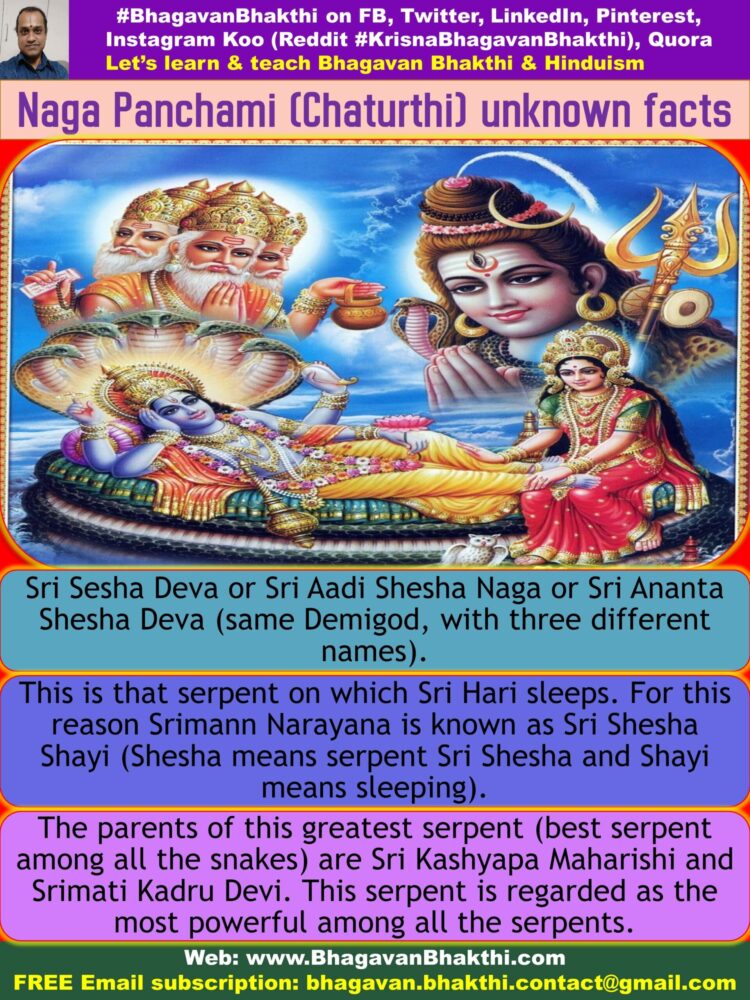
This is that serpent on which Lord Sri Hari (Vishnu) sleeps. For this reason Srimann Narayana is known as Sri Shesha Shayi. (Here, Shesha means the serpent Lord Sri Adishesha and Shayi means sleeping).
The parents of this greatest serpent Lord Sri Adishesha (best serpent among all the snakes) are Maharishi Kashyapa and Kadru Devi.
This serpent is regarded as the most powerful among all the serpents (Nagas) (Sarpas).
2. Lord Sri Kartikeya / Sri Subramanya / Sri Skanda / Sri Shanmugha (Same Devata / Demigod, with different names)

Lord Kartikeya is the son of Lord Shiva (Lord Sri Rudra Deva) and Goddess Sri Parvati Devi.
Lord Kartikeya is regarded as the army chief or chief soldier among the Demigods (Devatas). He is the protector of all the Devatas (Demigods).
Lord Kartikeya is said to be the second most powerful among all the serpents (Nagas) (Sarpas).
3. Lord Sri Vasuki – The the snake which will be present around the neck of Lord Shiva:
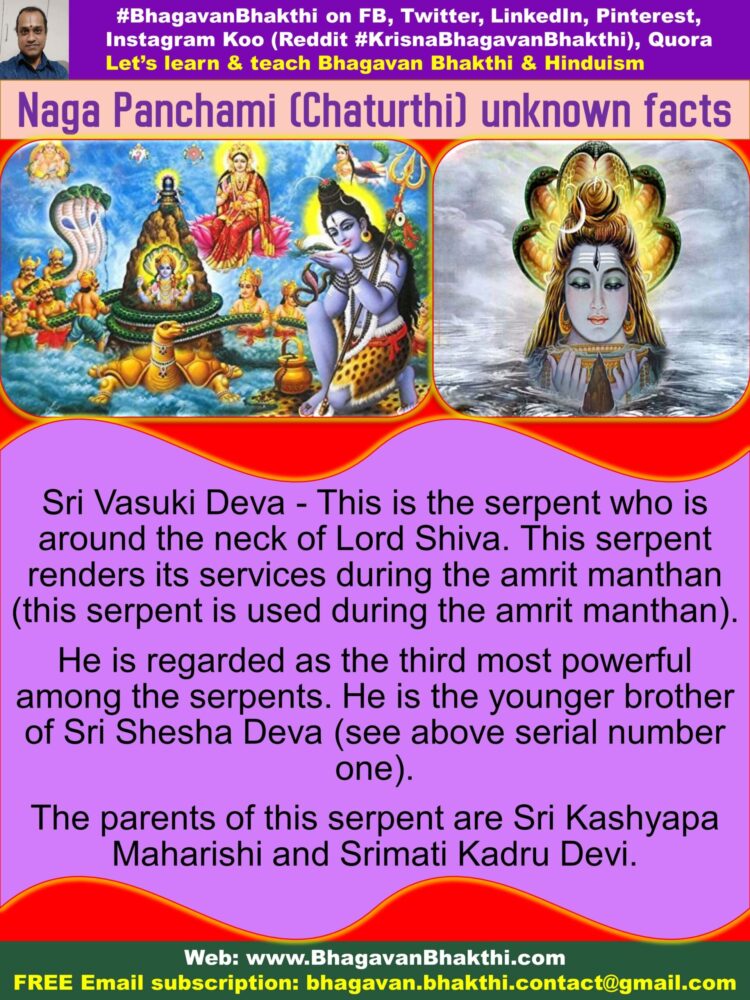
Lord Vasuki is the Naga (Sarpa) (Serpent) which will be present around the neck of Lord Shiva.
Lord Vasuki serpent renders its services during the amrit manthan (this serpent is used during the Amrit manthan / Samudra Manthan / Sagara Manthan).
Lord Vasuki is regarded as the third most powerful among the Nagas (Sarpas) (Serpents). Lord Vasuki is the younger brother of Lord Sri Adishesha Deva (see above serial number one for information).
The parents of Lord Vasuki the serpent are Maharishi Kashyapa and Kadru Devi.
Other significances of Nag (Naga) Panchami is as given below:
During the pooja on the auspicious day of Nag Panchami or Naga Panchami or Nagara Panchami, we need to pray for the above three great serpents.
First we need to pray Lord Sri Hari (Vishnu), and then we need to pray the above serpents in the hierarchical way.
That is, firstly to, Lord Sri Adishesha Deva or Sri Ananta Shesha Deva. Secondly to, Lord Kartikeya / Sri Subramanya / Sri Skanda / Sri Shanmugha / Kumara / Kumar. Thirdly to, Lord Sri Vasuki.
There are various Naga Devata Kshetras / pilgrimage places in India, which are as Naga Devata Kshetras.
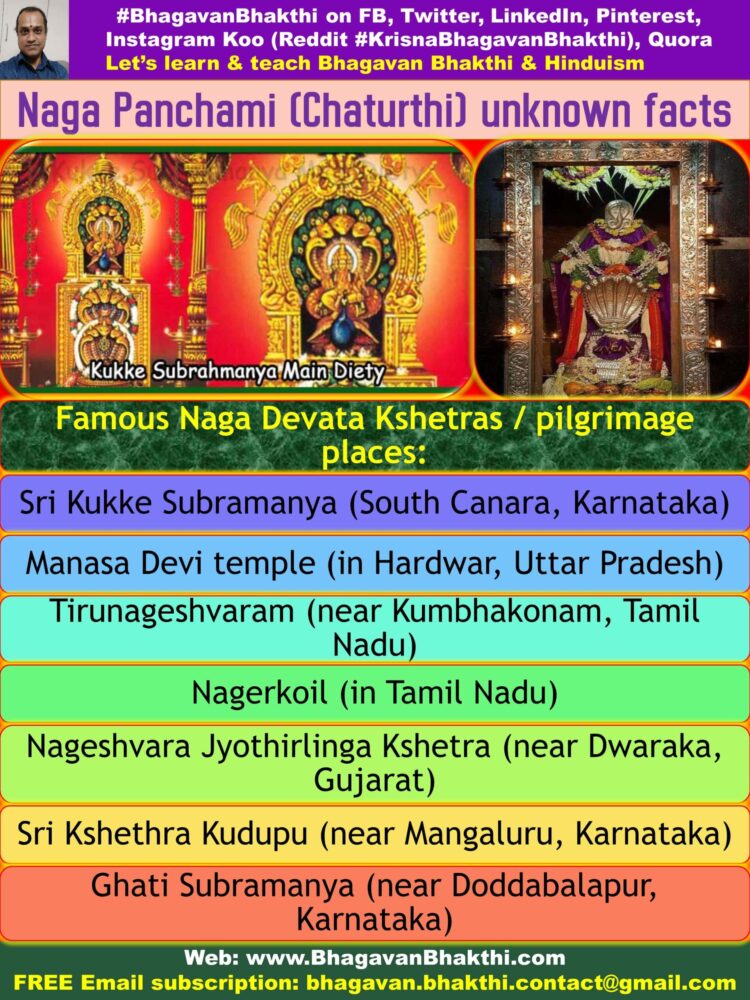
Few of the very famous and ancient Naga Devata Kshetras (pilgrimage place) that are associated with Hindu Sanatana Dharma is as given below:
Famous Naga Devata Kshetras / pilgrimage places is as given below:
Sri Kukke Subramanya (South Canara, Karnataka State)
Manasa Devi temple (in Hardwar, Uttar Pradesh)
Tirunageshvaram (near Kumbhakonam, Tamil Nadu)
Nagerkoil (in Tamil Nadu)
Nageshvara Jyothirlinga Kshetra (near Dwaraka, Gujarat)
Sri Kshethra Kudupu (near Mangaluru, Karnataka)
Ghati Subramanya (near Doddabalapur, Karnataka)
Apart from the above, there are six Lord Kartikeya / Subramanya / Muruga Kshetras (pilgrimage places) in Tamil Nadu as given below:
Thiruttani | Palani | Tiruchendur | Tirupparakundram | Swami Malai | Pazamudhircholai |
All the above are also worshiped as Naga Devata Kshetras (Pilgrimage places).
Now, let have more information on Naga Panchami (Chaturthi) as given below.
List of things needed for Naga Panchami (Chaturthi) day is as given below:
1. Silver Naga (Or a drawn picture Naga) or Rangavalli (Rangoli) form | 2. One good and clean Peetha for puja |
3. Water, milk, haldi, kumkum, akshata, gandha, flowers, vastra (clothes), fruits, deepa, arati. |
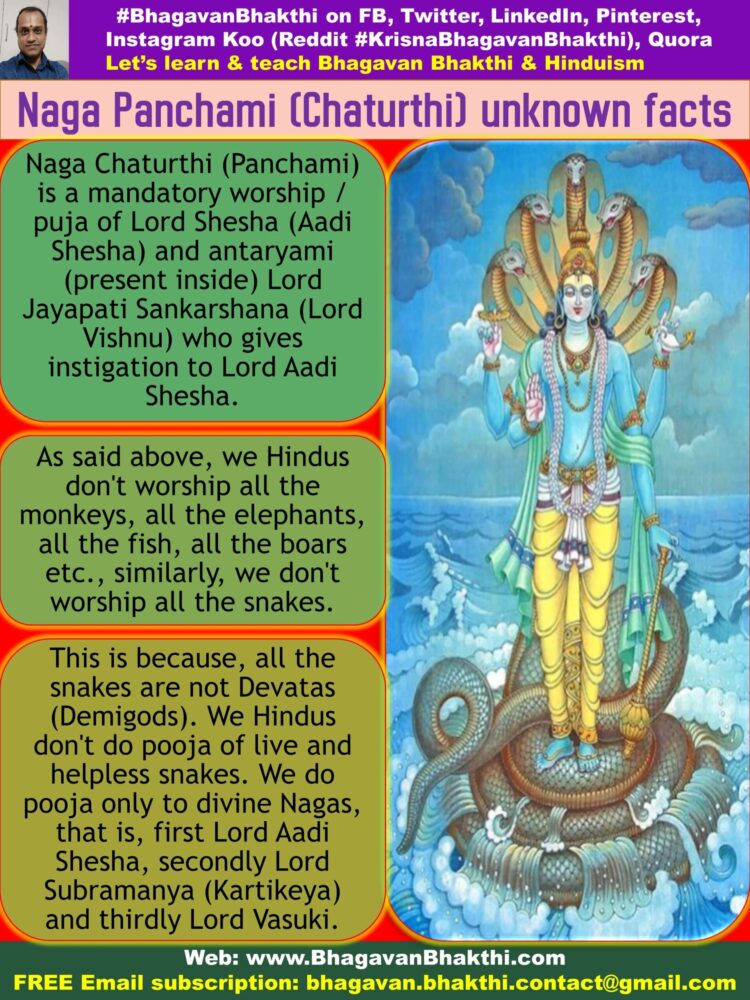
Naga Chaturthi (Panchami) is a mandatory worship / puja of Lord Shesha (AdiShesha) and antaryami (present inside) Lord Jayapati Sankarshana (Lord Vishnu) who gives instigation to Lord AdiShesha.
As said above, we Hindus don’t worship all the monkeys, all the elephants, all the fish, all the boars etc., similarly, we don’t worship all the snakes.
This is because, all the snakes are not Devatas (Demigods). We Hindus don’t do pooja of live and helpless snakes.
We do pooja only to divine Nagas, that is, first Lord AdiShesha, secondly Lord Subramanya (Kartikeya) and thirdly Lord Vasuki.
The first Lord of Nagas, that is, Lord AdiShesha will be near Lord Vishnu, second Lord of Nagas, that is –
Lord Subramanya (Kartikeya – Son of Lord Shiva) and third Lord of Nagas, that is, Lord Vasuki will be near the neck of Lord Shiva.
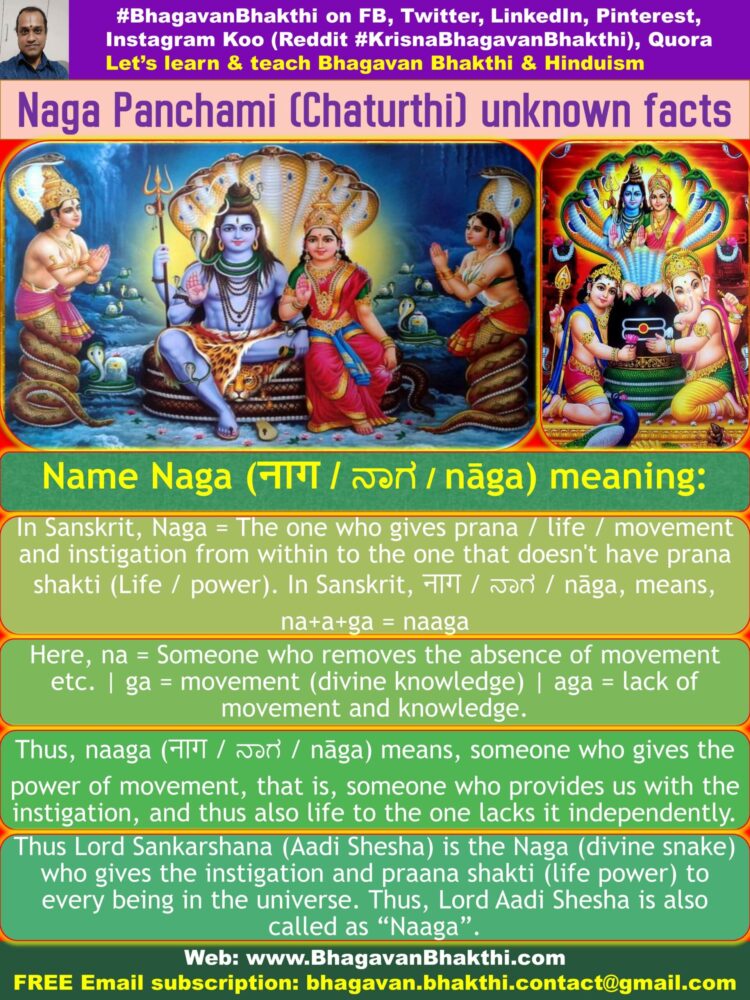
Name Naga (नाग / ನಾಗ / nāga) meaning is as given below:
In Sanskrit, Naga = The one who gives prana / life / movement and instigation from within to the one that doesn’t have prana shakti (Life / power).
In Sanskrit, नाग / ನಾಗ / nāga, means, na+a+ga = naaga.
Here, na = Someone who removes the absence of movement etc. | ga = movement (divine knowledge) | aga = lack of movement and knowledge.
Thus, naaga (नाग / ನಾಗ / nāga) means, someone who gives the power of movement, that is – someone who provides us with the instigation, and thus also life to the one lacks it independently.
Thus Lord Sankarshana (Lord AdiShesha, the serpent) is the Naga (divine snake) who gives the instigation and prana shakti (life power) to every being in the universe.
Thus, Lord AdiShesha is also called as “Naga”.
Lord AdiShesha can give this power with the help of Lord Sri Vayu Deva (Mukhya Prana Deva). Lord Sri Vayu Deva can do this with the blessings of Lord Sri Vishnu.
Lord AdiShesha has two forms. One is “purusha” form and other being ‘uraga‘ form (उरग / ಉರಗ / uraga) –
In Sanskrit uraga means Naga / Snake, that is, “snake” form just like how Lord Ganesha also has Elephant face apart from his original human face.
Lord AdiShesha is born from Lord Sri Brahma Deva and Goddess Sri Saraswati Devi, before the creation of the world.
As a divine and true son, along with Lord Sri Brahma Deva, Lord AdiShesha is staying inside each one of us as “kundalini shakti” and maintains “prana shakti”.
That is why Upanishads call Lord AdiShesha also as “prana / praana” (प्राण / ಪ್ರಾಣ / prāṇa, that is, power of life / movement).
“Prana shakti” (Power of life) is called as Shuchi (शुचि / ಶುಚಿ / śuci), that is, highly clean.
Thus, we do pranayama (प्राणायाम) (prāṇāyāma) when there is any anomaly during pooja.
For e.g., if we get angry or may get interruption, etc., that may affect mental purity and / or focus during pooja.
With this shakti (power), we can boost ourselves and evolve with higher divine thoughts in the adhyatmik way (spiritual way).
We should also know that, prana shakti (power of life) is also responsible mainly for “speech”.
The great Upanishads call Lord AdiShesha as “chanda purusha”. Speech is the output of well thought of mental concept.
Lord AdiShesha is also the deity of “मनो अभिमानि / ಮನೋ ಅಭಿಮಾನಿ / manō abhimāni“, that is, he is the controller of mind. Lord Shiva is also the controller of mind.
Thus we all owe our life, development through speech, mental upliftment to Lord AdiShesha.
But we should always remember that Lord Sri Vishnu is the main cause of everything including controlling our mind.
Lord AdiShesha, apart from being inside us, he is also present outside us.
Lord AdiShesha is also called as “संकर्षण / ಸಂಕರ್ಷಣ / sankarshana“, that is, shakti (power) aka “gravitational force”.
Lord AdiShesha bears the entire Universe without any effort on one of his hood (He has 1000 hoods).
This happens due to the presence of Lord Sankarshana (Lord Sri Vishnu) and Lord Sri Vayu Deva inside him as ‘antaryami‘.
In this universe, thus we owe our very existence and function with every individual with mutual likes and / or dislikes due to Lord AdiShesha’s ”pull of attraction”,
or the lack of “prana shakti” and his grace is thus vital for creation (children / future generation).
Like Lord AdiShesha, his parivara (family) which is of 8 key groups, that is –
“ashta maha naga”, also protect our life and santati (children / future generation).
Bhima and Nagas story is as given below:
The Ashta maha nagas (Eight great serpents) families were imprisoned due to the mantra shakti of Shukracharya (Guru of Rakshasas / Demons).
Duryodhana tried to poison Bhima in the young age.
Bhima saved all these Ashta maha nagas (Eight great serpents) from the clutches of Duryodhana at the very young age.
Thus, by praying these Ashta maha nagas (Eight great serpents) and also praying Bhima, we can easily protect our family too.

Those Ashta maha nagas (Eight great serpents) names are as give below:
अनन्तो वासुकिः पद्मो महापद्मश्च तक्षकः कर्कोटकः शन्खपालो महा-शन्खः
ಅನಂತೋ ವಾಸುಕಿಃ ಪದ್ಮೋ ಮಹಾಪದ್ಮಶ್ಚ ತಕ್ಷಕಃ ಕರ್ಕೋಟಕಃ ಶಂಖಪಾಲೋ ಮಹಾ-ಶಂಖಃ
anantō vāsukiḥ padmō mahāpadmaśca takṣakaḥ karkōṭakaḥ śaṅkhapālō mahā-śaṅkhaḥ
Those names are : Ananta, Vasuki, Padma, Mahapadma, Takshaka, Karkotaka, ShankhaPala and MahaShankha.
Thus, for progeny, Lord AdiShesha is worshiped.
Also, we should remember that Lord AdiShesha is the one who brings mutual affection between married couples, among two or more siblings, parents-children, etc.
For example, if a father lacks “shesha shakti”, then he may lack the love, mental attraction, inability to carry forward the family happiness, progeny (santana) etc.
Similarly, if a mother doesn’t gets Lord AdiShesha’s blessings, she will never hold on to the life force that has entered into her, that is, it may be either physically or mentally or both.
Not just the mere progeny (santana), but Lord AdiShesha, being “Chanda purusha” also controls the mind-speech co-ordination and also improves the worshiper (their children) –
to take the better path(s) and by providing rational, logical thinking and communication skill set to win over others in a way that protects Dharma.
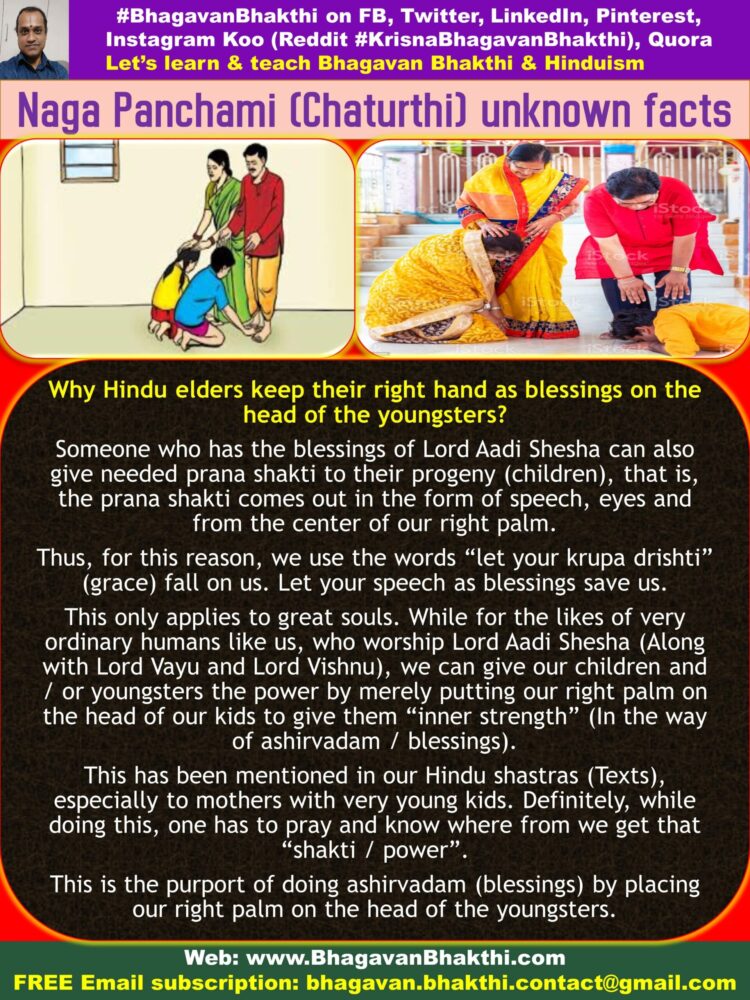
Why Hindu elders keep their right hand as blessings on the head of the youngsters?
Someone who has the blessings of Lord AdiShesha can also give needed prana shakti to their progeny (children), that is –
the prana shakti comes out in the form of speech, eyes and from the center of our right palm.
Thus, for this reason, we use the words “let your kripa drishti” (grace) fall on us.
Let your speech as blessings save us.
This only applies to great souls. While for the likes of very ordinary humans like us, who worship Lord AdiShesha (Along with Lord Vayu and Lord Vishnu),
we can give our children and / or youngsters the power by merely putting our right palm on the head of our kids to give them “inner strength” (In the way of ashirvadam / blessings).
This has been mentioned in our Hindu shastras (Texts), especially to mothers with very young kids.
Definitely, while doing this, one has to pray and know where from we get that “shakti / power”.
This is the purport of doing ashirvadam (blessings) by placing our right palm on the head of the youngsters.
Thus, the pooja is to show our divine gratitude daily and if not at least remember him with gratitude on Naga Chauti (Panchami) day.
Men, definitely have to do pooja with Veda mantra, while women do without Veda mantra.
Since women are the main cause of getting santana (progeny) and there by lifts both the families, that is –
the one in which she is born (mother’s house) and the one she goes to (husband’s house).
It is very important, that the women observes this pooja according to her best of capacity given by Lord Vishnu to her.
When the gratitude in the form of “thought, word and deed” is done, as we have seen above that,
Lord AdiShesha is the deity of “mind, vaak and chalana” is shown, thus definitely, Lord AdiShesha protects the worshiper and her siblings, progeny (children), her students with wisdom and long life.
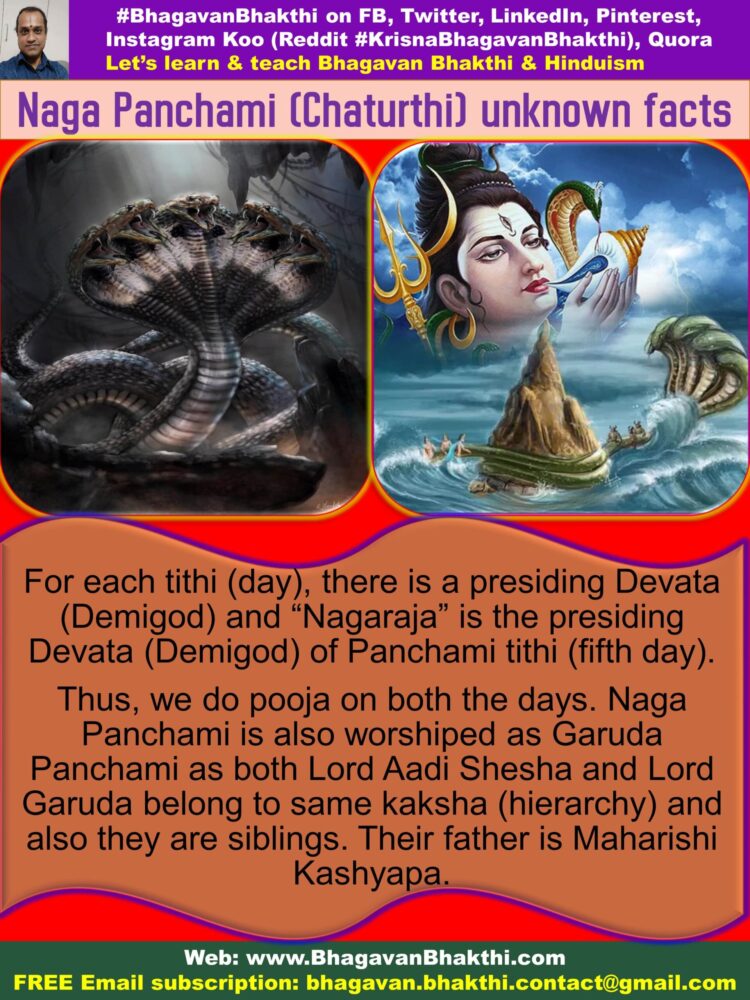
For each tithi (day), there is a presiding Devata (Demigod) and “Nagaraja” is the presiding Devata (Demigod) of Panchami tithi (fifth day).
Thus, we do pooja on both the days.
Naga Panchami is also worshiped as Garuda Panchami as both Lord AdiShesha and Lord Garuda belong to same kaksha (hierarchy) and also they are siblings.
Their father is Maharishi Kashyapa.
Only when there is both deha and mano shuchi (cleanliness of mind and body), Lord AdiShesha grace will be present.
Thus, shuchitva (cleanliness) is given utmost importance.
Also, telling or listening or remembering Story of Astika (8 serpents), that is –
as to how Lord AdiShesha saved the good snakes like Takshaka from the sarpa yajna, will keep ourselves and our families away from poisonous serpents etc.
For example : Just like how it paved way for Janamejaya (Son of King Parikshita) by listening Mahabharata from Rishi Vaishampayana.
So also let Bhagavan Sri Krishna as antaryami (present inside us) will help us to do ‘nirantara shastra-shravana’
(Regularly listening Hindu texts like Mahabharata, Bhagavatam, etc.) especially in this month of Shravana, whose abhimani devata (controlling God) is Lord Indra.
Let Lord Indra bless us to do shravana, manana, dhyana (hearing, memorizing, meditation) and take us close to Lord Dhanya Shridhara (Vishnu).
Lord Dhanya Shridhara (Vishnu) is the main niyamaka devata (controlling main God) of this shravana masam (month).

Dhanya meaning
We should note that, here “Dhanya” not only refers to the Goddess Lakshmi Laxmi roopa (form), but it also refers to the Bhagavatrupa in Her, that too especially in this month of shravana.
Please remember that, Dhanya means the one who has all the Soubhagya gunas (Auspicious qualities) as His svabhavaika guna (Common quality), that is –
such a Soubhagya guna is non-different from Him. This is just like how sweetness is non-different from sugar itself.
Dhanya shabda (word) also has the meaning that, he is someone who makes the truthfulness in the faulty arguments of the evil ones non-existent like the ashtama rasa (Eighth rasa).
Just as ashtama rasa (Eighth rasa) never exists, the truthfulness in the faulty arguments also never exists.
One can eliminate the faults in oneself by doing smarana of “Dhanya rupi Bhagavan” (Lord Vishnu) in Goddess Lakshmi.
Such a Lakshmi is protected and supported by Lord Sridhara (Vishnu).
Apart from remembering the Astika story, Bhima’s protection on ashta maha nagas etc., one has to see Lord AdiShesha in every jaDa pratika that we use today for worship.
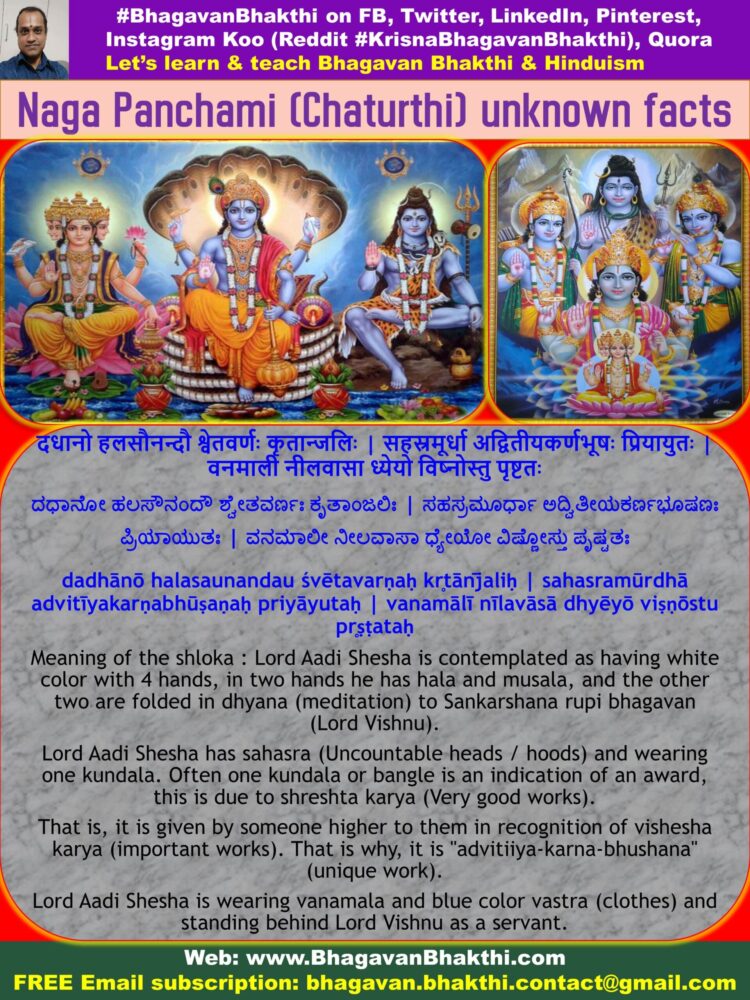
The description is given by Sri Madhvadharya Ji in Tantra Saara Sangraha as given below:
दधानो हलसौनन्दौ श्वेतवर्णः कृतान्जलिः | सहस्रमूर्धा अद्वितीयकर्णभूषः प्रियायुतः | वनमाली नीलवासा ध्येयो विष्नोस्तु पृष्टतः
ದಧಾನೋ ಹಲಸೌನಂದೌ ಶ್ವೇತವರ್ಣಃ ಕೃತಾಂಜಲಿಃ | ಸಹಸ್ರಮೂರ್ಧಾ ಅದ್ವಿತೀಯಕರ್ಣಭೂಷಣಃ ಪ್ರಿಯಾಯುತಃ | ವನಮಾಲೀ ನೀಲವಾಸಾ ಧ್ಯೇಯೋ ವಿಷ್ಣೋಸ್ತು ಪೃಷ್ಟತಃ
dadhānō halasaunandau śvētavarṇaḥ kr̥tān̄jaliḥ | sahasramūrdhā advitīyakarṇabhūṣaṇaḥ priyāyutaḥ | vanamālī nīlavāsā dhyēyō viṣṇōstu pr̥ṣṭataḥ
Meaning of the shloka : Lord AdiShesha is contemplated as having white color with 4 hands,
in two hands he has hala and musala, and the other two are folded in dhyana (meditation) to Sankarshana rupi bhagavan (Lord Vishnu).
Lord AdiShesha has sahasra (Uncountable heads / hoods) and wearing one kundala.
Often one kundala or bangle is an indication of an award, this is due to shreshta karya (Very good works).
That is, it is given by someone higher to them in recognition of vishesha karya (important works). That is why, it is “advitiiya-karna-bhushana” (unique work).
Lord AdiShesha is wearing vanamala and blue color vastra (clothes) and standing behind Lord Vishnu as a servant.

Lord AdiShesha is the dharaka (holder) of not only this brahmanda (universe), but also our own deha (body).
Lord AdiShesha is the sharira purusha (Divine person with divine body) protecting our sharira (body) and gives prana shakti (Power of life).
In puranjanopakyana [bha.pu 4.24] this “sarpa” is mentioned as the rakshaka (protector) for our deha (body).
Here, we should always remember that whatever is done by any Devata (Demigod) including Lord AdiShesha is originally done by Lord Vishnu.
Without Lord Vishnu’s help, no one can do anything.
Our pooja becomes complete if and only if when we do “aikya chintana”, that is –
non-difference in the Bhagavat Rupas (Lord Vishnu’s different forms) that exist everywhere outside (bahishhTam) with that of the bimbarupa inside us (jiva-antastha).
This is samanvaya pooja. The vyatirekha pooja is noticing the difference and gradation in the adhistana of these bhagavat rupa.
Together they become parama-archanam.
More information will be added to his post (article) on regular basis. Please visit again to know the updated information after some time.
To watch videos on #Hinduism #Sanskrit language, SUBSCRIBE to my YouTube channel from this below link:
#BhagavanBhakthi YouTube channel
To know about the Garuda panchami, you can click this below link:
What are Garuda Panchami unknown facts
Dear friends, if you need any clarifications about this post, kindly let me know, I will definitely try to answer all of them.
Also your one LIKE, one COMMENT, One Share, one SUBSCRIPTION is highly important.
This will help to know the quality of this content and also it will be helpful to know if any improvements is required for the content.
If you feel this content is useful to you and has helped you to improve your knowledge, kindly share this with your well-wishers.
Because “SHARING MEANS CARING”.
For receive FREE EMAIL SUBSCRIPTION about #BhagavanBhakthi, you can send an email to [email protected] from your email ID.
NAMASTE!
Sri Gurubhyo Namaha
Sri Krishnaaya Namaha
Sri Krishnaarpanamastu
Subscribe / Follow us Share in Social Media